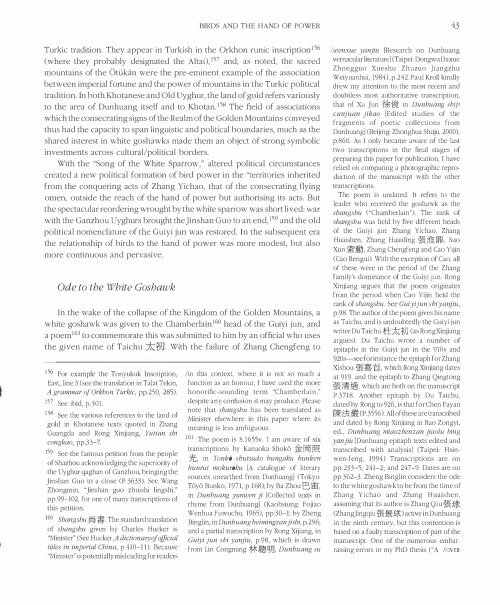East Asian History - ANU
East Asian History - ANU
East Asian History - ANU
- No tags were found...
You also want an ePaper? Increase the reach of your titles
YUMPU automatically turns print PDFs into web optimized ePapers that Google loves.
BIRDS AND THE HAND OF POWER43Turkic tradition. They appear in Turkish in the Orkhon runic inscription 156(where they probably designated the Altai),157 and, as noted, the sacredmountains of the Otukan were the pre-eminent example of the associationbetween imperial fortune and the power of mountains in the Turkic politicaltradition. In both Khotanese and Old Uyghur, the land of gold refers variouslyto the area of Dunhuang itself and to Khotan.158 The field of associationswhich the consecrating signs of the Realm of the Golden Mountains conveyedthus had the capacity to span linguistic and political boundaries, much as theshared interest in white goshawks made them an object of strong symbolicinvestments across cultural/political borders.With the "Song of the White Sparrow," altered political circumstancescreated a new political formation of bird power in the "territories inheritedfrom the conquering acts of Zhang Yichao, that of the consecrating flyingomen, outside the reach of the hand of power but authorising its acts. Butthe spectacular reordering wrought by the white sparrow was short lived: warwith the Ganzhou Uyghurs brought the Jinshan Guo to an end, 159 and the oldpolitical nomenclature of the Guiyi jun was restored. In the subsequent erathe relationship of birds to the hand of power was more modest, but alsomore continuous and pervasive.Ode to the Wh ite GoshawkIn the wake of the collapse of the Kingdom of the Golden Mountains, awhite goshawk was given to the Chamberlain160 head of the Guiyi jun, anda poem161 to commemorate this was submitted to him by an official who usesthe given name of Taichu :::tM. With the failure of Zhang Chengfeng to156 For example the Tonyukuk Inscription,<strong>East</strong>, line 3 (see the translation in Talat Tekin,A grammar oj Orkhon Turkic, pp.250, 285).157 See ibid, p.301.158 See the various references to the land ofgold in Khotanese texts quoted in ZhangGuangda and Rong Xinjiang, Yutian shicongkao, pp.33-7.159 See the famous petition from the peopleof Shazhou acknowledging the su periority ofthe Uyghur qaghan of Ganzhou, bringing theJinshan Guo to a close (P.3633), See WangZhongmin, "Jinshan guo zhuishi lingshi,"pp.99-102, for one of many transcriptions ofthis petition.160 Shangshu j>iij. The standard translationof shangshu given by Charles Hucker is"Minister" (See Hucker,A dictionaryojojJicialtitles in imperial China, p.410-H). Because"Minister" is potentially misleading for readerslin this context, where it is not so much afunction as an honour, I have used the morehonorific-sounding term "Chamberlain,"despite any confusion it may produce. Pleasenote that shangshu has been translated asMinister elsewhere in this paper where itsmeaning is less ambiguous.161 The poem is s.1655v. I am aware of sixtranscriptions: by Kanaoka Shoko :!iZ: Iti'd 7\:;, in Tonka shu/sudo bungaku bunkenbunrui mokuroku [A catalogue of literarysources unearthed from Dunhuang] (Tokyo:Toyo Bunko, 1971, p.168); by Ba Zhou E:l m,in Dunhuang yunwen ji [Collected texts inrhyme from Dunhuang] (Kaohsiung: FojiaoWenhua Fuwuchu, 1965), pp.30-1; by ZhengBinglin, in Dunhuang beimingzan jishi, p.296;and a partial transcription by Rong Xijiang, inGuiyi jun shi yanjiu, p.98, which is drawnfrom Lin Congming #WEJI3, Dunhuang suIwenxue yanjiu [Research on Dunhuangvernacular literature] (Taipei: Dongwu DaxueZhongguo Xueshu Zhuzuo JiangzhuWeiyuanhui, 1984), p.242. Paul Kroll kindlydrew my attention to the most recent anddoubtless most authoritative transcription,that of Xu Jun f in Dunhuang shijicanjuan jikao [Edited studies of thefragments of poetic collections fromDunhuang] (Beijing: Zhonghua Shuju, 2000),p.860. As I only became aware of the lasttwo transcriptions in the final stages ofpreparing this paper for publication, I haverelied on comparing a photographic reproductionof the manuscript with the othertranscriptions.The poem is undated. It refers to theleader who received the goshawk as theshangshu ("Chamberlain"). The rank ofshangshu was held by five different headsof the Guiyi jun: Zhang Yichao, ZhangHuaishen, Zhang Huaiding 5i$$, SuoXun mtJ, Zhang Chengfeng and Cao Yijin(Cao Rengui). With the exception of Cao, allof these were in the period of the Zhangfamily'S dominance of the Guiyi jun. RongXinjiang argues that the poem originatesfrom the period when Cao Yijin held therank of shangshu. See Guiyi jun shi yanjiu,p.98. The author of the poem gives his nameas Taichu, and is undoubtedly the Guiyi junwriter Du Taichu tl:*tJJ (as RongXinjiangargues). Du Taichu wrote a number ofepitaphs in the Guiyi jun in the 910s and920s-see for instance the epitaph for ZhangXishou 5i:g§" which Rong Xinjiang datesat 919, and the epitaph to Zhang Qingtong5im, which are both on the manuscriptP.3718. Another epitaph by Du Taichu,dated by Rong to 926, is that for Chen Fayani!*(P.3556). All of these are transcribedand dated by Rong Xinjiang in Rao Zongyi,ed., Dunhuang miaozhenzan jiaolu bingyanjiu [Dunhuang epitaph texts edited andtranscribed with analysis] (Taipei: Hsinwen-feng,1994) Transcriptions are onpp.233-5, 241-2; and 247-9. Dates are onpp.362-3. Zheng Binglin considers the odeto the white goshawk to be from the time ofZhang Yichao and Zhang Huaishen,assuming that its author is Zhang Qiu 5iRlt(ZhangJingqiu 5iRIt) active in Dunhuangin the ninth century, but this contention isbased on a faulty transcription of part of themanuscript. One of the numerous embarrassingerrors in my PhD thesis ("A lOVER
















